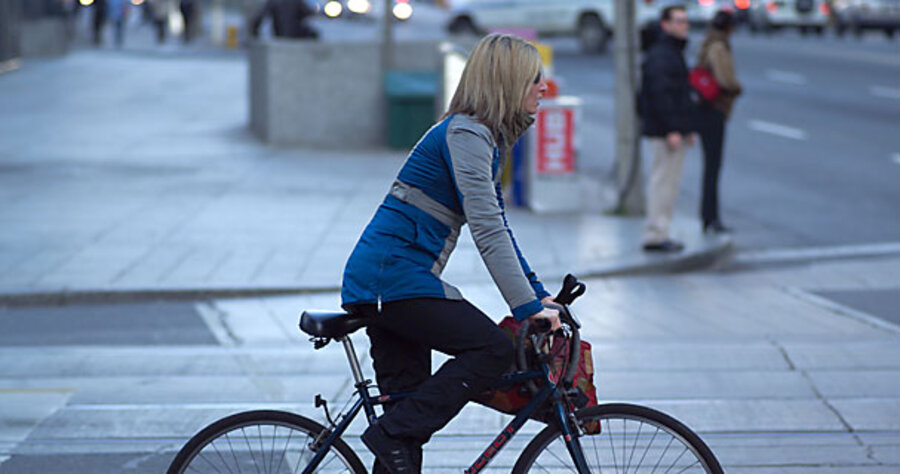In Toronto, cyclists form a first-of-its-kind union
Loading...
| Toronto
Kathy Marks cocks her head, listening for the din of a thousand bicycle bells. For the Toronto grandmother, it’s a cue to hop on her three-speed bicycle and join a riding protest for more bike lanes in Canada’s largest city.
But after several years of participating in this annual demonstration, she’s considering joining a new group of rabble-rousers to show her dissatisfaction with cycling conditions here: the Toronto Cyclists Union.
“I’ve been riding my bike for nearly 40 years in the city, and it’s high time we have something like a union,” Ms. Marks explained last weekend. “I don’t fly around like the youngsters. But if we were able to have better bike lanes and benefits like a union, you’d see more people out here who are my age.”
Believed to be a global first, the union already has enrolled hundreds of card-carrying members since it formed in May. Modeled on auto programs like AAA, the union plans to offer members insurance, roadside assistance, and advocacy on their behalf – all for a $24 annual fee.
“Our primary goal is give a voice to urban cyclists who use their bikes in their daily lives as a mode of transportation,” explains David Meslin, founder of the Toronto Cyclists Union. “Cyclists don’t feel safe on the streets, and if they know there is a group fighting for safer conditions, I believe a lot more will join.”
With 130 miles of dedicated bike lanes, Toronto is out in front of other major Canadian cities such as Montreal (110 miles) and Vancouver (64 miles). But its bike lanes are less connected than in Vancouver, which many of Toronto’s 400,000 utilitarian cyclists – those who cycle to work, school, or on their errands each day – say has made better progress.
“Toronto was way ahead 10 to 15 years ago and it fell way behind Vancouver,” says bike-union coordinator Rick Conroy. “Vancouver has put a lot more thought, care, and money into their bike lanes in recent years.”
To get up to speed, one of the union’s first tasks will be to lobby the City of Toronto to implement a “visionary” plan for cyclists commissioned in 2001 but never fully implemented.
Still, with 30 miles of new bikeways planned for Toronto this year, Mr. Meslin says he’s optimistic that there is more political will to accommodate bicycling as a critical form of urban transportation. “The pace is quickening,” he says.
“We’re not doing that badly when you compare us to cities like New York,” agrees former mayor John Sewell, who was seen as eccentric back in the 1970s when he eschewed a limousine for a bicycle. “But I believe that the city could do a lot more. Some of the main streets are throwing cyclists right in the road of traffic.”
As the front-runner in politics on the bicycling issue, Mr. Sewell hopes current city politicians will break out of the pack to support the bicycle union’s agenda.
In the coming months, the bike union hopes to build momentum by reaching out to newcomers, including immigrants. Eventually, it even hopes to offer an online dating service for urban road warriors. “That’s one service I would definitely use,” says Marks, before pedaling off with her fellow protesters.





